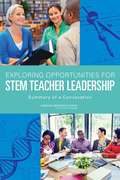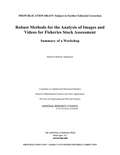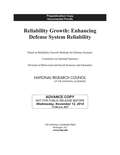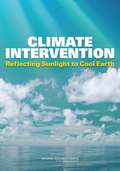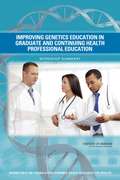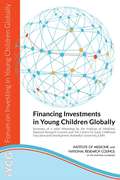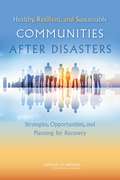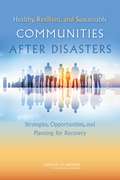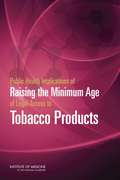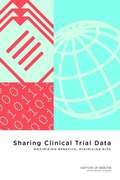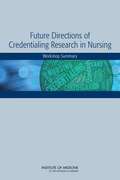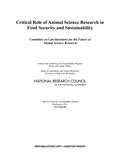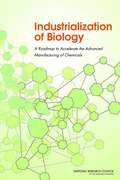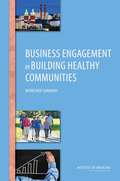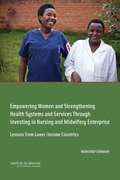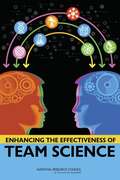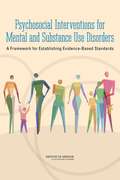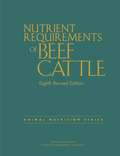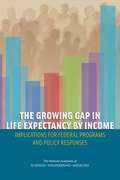- Table View
- List View
Exploring Opportunities for STEM Teacher Leadership: Summary of a Convocation
by Steve OlsonMany national initiatives in K-12 science, technology, engineering, and mathematics (STEM) education have emphasized the connections between teachers and improved student learning. Much of the discussion surrounding these initiatives has focused on the preparation, professional development, evaluation, compensation, and career advancement of teachers. Yet one critical set of voices has been largely missing from this discussion - that of classroom teachers themselves. To explore the potential for STEM teacher leaders to improve student learning through involvement in education policy and decision making, the National Research Council held a convocation in June 2014 entitled "One Year After Science's Grand Challenges in Education: Professional Leadership of STEM Teachers through Education Policy and Decision Making. " This event was structured around a special issue of Science magazine that discussed 20 grand challenges in science education. The authors of three major articles in that issue - along with Dr. Bruce Alberts, Science's editor-in-chief at the time - spoke at the convocation, updating their earlier observations and applying them directly to the issue of STEM teacher leadership. The convocation focused on empowering teachers to play greater leadership roles in education policy and decision making in STEM education at the national, state, and local levels. "Exploring Opportunities for STEM Teacher Leadership" is a record of the presentations and discussion of that event. This report will be of interest to STEM teachers, education professionals, and state and local policy makers.
Robust Methods for the Analysis of Images and Videos for Fisheries Stock Assessment: Summary of a Workshop
by Maureen MellodyThe National Marine Fisheries Service (NMFS) is responsible for the stewardship of the nation's living marine resources and their habitat. As part of this charge, NMFS conducts stock assessments of the abundance and composition of fish stocks in several bodies of water. At present, stock assessments rely heavily on human data-gathering and analysis. Automatic means of fish stock assessments are appealing because they offer the potential to improve efficiency and reduce human workload and perhaps develop higher-fidelity measurements. The use of images and video, when accompanies by appropriate statistical analyses of the inferred data, is of increasing importance for estimating the abundance of species and their age distributions. "Robust Methods for the Analysis of Images and Videos for Fisheries Stock Assessment" is the summary of a workshop convened by the National Research Council Committee on Applied and Theoretical Statistics to discuss analysis techniques for images and videos for fisheries stock assessment. Experts from diverse communities shared perspective about the most efficient path toward improved automation of visual information and discussed both near-term and long-term goals that can be achieved through research and development efforts. This report is a record of the presentations and discussions of this event.
Reliability Growth: Enhancing Defense System Reliability
by Panel on Reliability Growth Methods for Defense SystemsA high percentage of defense systems fail to meet their reliability requirements. This is a serious problem for the U. S. Department of Defense (DOD), as well as the nation. Those systems are not only less likely to successfully carry out their intended missions, but they also could endanger the lives of the operators. Furthermore, reliability failures discovered after deployment can result in costly and strategic delays and the need for expensive redesign, which often limits the tactical situations in which the system can be used. Finally, systems that fail to meet their reliability requirements are much more likely to need additional scheduled and unscheduled maintenance and to need more spare parts and possibly replacement systems, all of which can substantially increase the life-cycle costs of a system. Beginning in 2008, DOD undertook a concerted effort to raise the priority of reliability through greater use of design for reliability techniques, reliability growth testing, and formal reliability growth modeling, by both the contractors and DOD units. To this end, handbooks, guidances, and formal memoranda were revised or newly issued to reduce the frequency of reliability deficiencies for defense systems in operational testing and the effects of those deficiencies. "Reliability Growth" evaluates these recent changes and, more generally, assesses how current DOD principles and practices could be modified to increase the likelihood that defense systems will satisfy their reliability requirements. This report examines changes to the reliability requirements for proposed systems; defines modern design and testing for reliability; discusses the contractor's role in reliability testing; and summarizes the current state of formal reliability growth modeling. The recommendations of "Reliability Growth" will improve the reliability of defense systems and protect the health of the valuable personnel who operate them.
Climate Intervention: Reflecting Sunlight to Cool Earth
by Committee on Geoengineering Climate: Technical Evaluation Discussion Of ImpactsThe growing problem of changing environmental conditions caused by climate destabilization is well recognized as one of the defining issues of our time. The root problem is greenhouse gas emissions, and the fundamental solution is curbing those emissions. Climate geoengineering has often been considered to be a "last-ditch" response to climate change, to be used only if climate change damage should produce extreme hardship. Although the likelihood of eventually needing to resort to these efforts grows with every year of inaction on emissions control, there is a lack of information on these ways of potentially intervening in the climate system. As one of a two-book report, this volume of "Climate Intervention" discusses albedo modification - changing the fraction of incoming solar radiation that reaches the surface. This approach would deliberately modify the energy budget of Earth to produce a cooling designed to compensate for some of the effects of warming associated with greenhouse gas increases. The prospect of large-scale albedo modification raises political and governance issues at national and global levels, as well as ethical concerns. "Climate Intervention: Reflecting Sunlight to Cool Earth" discusses some of the social, political, and legal issues surrounding these proposed techniques. It is far easier to modify Earth's albedo than to determine whether it should be done or what the consequences might be of such an action. One serious concern is that such an action could be unilaterally undertaken by a small nation or smaller entity for its own benefit without international sanction and regardless of international consequences. Transparency in discussing this subject is critical. In the spirit of that transparency, "Climate Intervention: Reflecting Sunlight to Cool Earth" was based on peer-reviewed literature and the judgments of the authoring committee; no new research was done as part of this study and all data and information used are from entirely open sources. By helping to bring light to this topic area, this book will help leaders to be far more knowledgeable about the consequences of albedo modification approaches before they face a decision whether or not to use them.
Evaluation of the Transport Airplane Risk Assessment Methodology
by National Academies of Sciences, Engineering, and Medicine Division on Engineering and Physical Sciences Aeronautics and Space Engineering Board Committee on Transport Airplane Risk Assessment MethodologyThe Transport Airplane Risk Assessment Methodology (TARAM) is a process for calculating risk associated with continued operational safety issues in the U.S. transport airplane fleet. TARAM is important because its risk-analysis calculations are used when making determinations of unsafe conditions in transport airplanes and when selecting and implementing corrective actions. This report assesses the TARAM process used by the FAA in its efforts to improve the overall safety of the transport airplane fleet. A healthy safety culture requires commitment to continuous improvement. This report provides recommendations to the FAA to address the gaps and strengthen the TARAM.
The Use and Effectiveness of Powered Air Purifying Respirators in Health Care: Workshop Summary
by Catharyn T. LivermanProtecting 18 million United States health care workers from infectious agents - known and unknown - involves a range of occupational safety and health measures that include identifying and using appropriate protective equipment. The 2009 H1N1 influenza pandemic and the 2014 Ebola virus outbreak in West Africa have called raised questions about how best to ensure appropriate and effective use of different kinds of personal protective equipment such as respirators, not only to promote occupational safety but also to reduce disease transmission. "The Use and Effectiveness of Powered Air Purifying Respirators in Health Care" is the summary of a workshop convened by the Institute of Medicine Standing Committee on Personal Protective Equipment for Workplace Safety and Health to explore the current state of practices and research related to powered air purifying respirator (PAPRs) and potential updates to performance requirements. Presentations and discussions highlighted current health care practices using PAPRs and outlined the research to date on the use and effectiveness of PAPRs in health care settings with a focus on the performance requirements. "The Use and Effectiveness of Powered Air Purifying Respirators in Health Care" focuses on efficacy, current training, maintenance, supplies, and possible enhancements and barriers to use in inpatient, clinic, nursing home, and community (home) settings. This report also explores the strengths and weaknesses of using various approaches to health care PAPR standards.
Review of VA Clinical Guidance for the Health Conditions Identified by the Camp Lejeune Legislation
by Committee on the Review of Clinical Guidance for the Care of Health Conditions Identified by the Camp Lejeune LegislationU. S. Marine Corps Base Camp Lejeune, located in eastern North Carolina, is a large installation that covers 156,000 acres and is home at any given time to a population of about 170,000 active-duty personnel, family members, retirees, and civilian employees living on base or in the surrounding community. Between 1957 and 1987, the ground water at Camp Lejeune was inadvertently contaminated with chemicals, primarily industrial solvents that are now known to cause cancer and other health problems. In 1980, drinking water contaminants, primarily trichloroethylene (TCE) and perchloroethylene (PCE), as well as other solvents, were first detected at Camp Lejeune in treated drinking water. The contaminated wells were closed in 1987. In 1989, the U. S. Environmental Protection Agency placed Camp Lejeune on the National Priorities List, also known as Superfund. It is estimated that between 500,000 and 1,000,000 people may have used the contaminated water and many of them continue to have concerns about the long-term effects that might result from that exposure. In 2012 Congress passed the Honoring America's Veterans and Caring for Camp Lejeune Families Act. The law provides health benefits to veterans and family members who have any of 15 health outcomes associated with exposure to TCE, PCE, or solvent mixtures. At the request of the Veteran's Administration, Review of the VA Guidance for the Health Conditions Identified by the Camp Lejeune Legislation reviews the latest scientific literature to ensure that the clinical guidance provided for the 15 covered medical conditions is scientifically sound. This report also describes the medical conditions that result from renal toxicity due to solvent exposures and characterizes neurobehavioral effects as mandated for coverage in the law.
Improving Genetics Education in Graduate and Continuing Health Professional Education: Workshop Summary
by Adam C. BergerMany health care providers do not have either the knowledge or the tools they need in order to apply genetic information in their day-to-day practices. This lack of support is contributing to a substantial delay in the translation of genetic research findings, when appropriate, into improvement in patient outcomes within the health care system. Although the need to improve genetics knowledge among health care providers is clear, the best approaches to educating health care providers in a way that produces meaningful changes in clinical practice are not, especially given the competing coursework and training needs that exist in today's increasingly complex health care settings. To examine the potential and the challenges of providing genetics education, the Roundtable on Translating Genomic-Based Research for Health of the Institute of Medicine hosted a workshop on August 18, 2014. The workshop examined a variety of approaches that could improve the teaching of genetics in the graduate and continuing education of health professionals; these approaches included online and interactive instruction, just-in-time approaches, the development of clinical decision-support tools, and the incorporation of genetics requirements into licensing and accreditation. This report summarizes the presentations and discussion of the event.
Financing Investments in Young Children Globally: Summary of a Joint Workshop by the Institute of Medicine, National Research Council, and The Centre for Early Childhood Education and Development, Ambedkar University, Delhi
by Deepali M. PatelIn January 2014, the Board on Children, Youth, and Families of the Institute of Medicine and the National Research Council, in collaboration with the IOM Board on Global Health, launched the Forum on Investing in Young Children Globally. At this meeting, the participants agreed to focus on creating and sustaining, over 3 years, an evidence-driven community of stakeholders that aims to explore existing, new, and innovative science and research from around the world and translate this evidence into sound and strategic investments in policies and practices that will make a difference in the lives of children and their caregivers. Financing Investments in Young Children Globally is the summary of a workshop hosted by the Forum on Investing in Young Children Globally in August 2014. This workshop, on financing investments for young children, brought together stakeholders from such disciplines as social protection, nutrition, education, health, finance, economics, and law and included practitioners, advocates, researchers, and policy makers. Presentations and discussions identified some of the current issues in financing investments across health, education, nutrition, and social protection that aim to improve children's developmental potential. This report explores issues across three broad domains of financing: (1) costs of programs for young children; (2) sources of funding, including public and private investments; and (3) allocation of these investments, including cash transfers, microcredit programs, block grants, and government restructuring.
Healthy, Resilient, and Sustainable Communities After Disasters: Strategies, Opportunities, and Planning for Recovery
by Committee on Post-Disaster Recovery of a Community's Public Health Medical Social ServicesIn the devastation that follows a major disaster, there is a need for multiple sectors to unite and devote new resources to support the rebuilding of infrastructure, the provision of health and social services, the restoration of care delivery systems, and other critical recovery needs. In some cases, billions of dollars from public, private and charitable sources are invested to help communities recover. National rhetoric often characterizes these efforts as a "return to normal. " But for many American communities, pre-disaster conditions are far from optimal. Large segments of the U. S. population suffer from preventable health problems, experience inequitable access to services, and rely on overburdened health systems. A return to pre-event conditions in such cases may be short-sighted given the high costs - both economic and social - of poor health. Instead, it is important to understand that the disaster recovery process offers a series of unique and valuable opportunities to improve on the status quo. Capitalizing on these opportunities can advance the long-term health, resilience, and sustainability of communities - thereby better preparing them for future challenges. "Healthy, Resilient, and Sustainable Communities After Disasters" identifies and recommends recovery practices and novel programs most likely to impact overall community public health and contribute to resiliency for future incidents. This book makes the case that disaster recovery should be guided by a healthy community vision, where health considerations are integrated into all aspects of recovery planning before and after a disaster, and funding streams are leveraged in a coordinated manner and applied to health improvement priorities in order to meet human recovery needs and create healthy built and natural environments. The conceptual framework presented in "Healthy, Resilient, and Sustainable Communities After Disasters" lays the groundwork to achieve this goal and provides operational guidance for multiple sectors involved in community planning and disaster recovery. "Healthy, Resilient, and Sustainable Communities After Disasters" calls for actions at multiple levels to facilitate recovery strategies that optimize community health. With a shared healthy community vision, strategic planning that prioritizes health, and coordinated implementation, disaster recovery can result in a communities that are healthier, more livable places for current and future generations to grow and thrive - communities that are better prepared for future adversities.
Healthy, Resilient, and Sustainable Communities After Disasters: Strategies, Opportunities, and Planning for Recovery
by Committee on Post-Disaster Recovery of a Community’s Public Health Medical Social ServicesIn the devastation that follows a major disaster, there is a need for multiple sectors to unite and devote new resources to support the rebuilding of infrastructure, the provision of health and social services, the restoration of care delivery systems, and other critical recovery needs. In some cases, billions of dollars from public, private and charitable sources are invested to help communities recover. National rhetoric often characterizes these efforts as a "return to normal. " But for many American communities, pre-disaster conditions are far from optimal. Large segments of the U. S. population suffer from preventable health problems, experience inequitable access to services, and rely on overburdened health systems. A return to pre-event conditions in such cases may be short-sighted given the high costs - both economic and social - of poor health. Instead, it is important to understand that the disaster recovery process offers a series of unique and valuable opportunities to improve on the status quo. Capitalizing on these opportunities can advance the long-term health, resilience, and sustainability of communities - thereby better preparing them for future challenges. "Healthy, Resilient, and Sustainable Communities After Disasters" identifies and recommends recovery practices and novel programs most likely to impact overall community public health and contribute to resiliency for future incidents. This book makes the case that disaster recovery should be guided by a healthy community vision, where health considerations are integrated into all aspects of recovery planning before and after a disaster, and funding streams are leveraged in a coordinated manner and applied to health improvement priorities in order to meet human recovery needs and create healthy built and natural environments. The conceptual framework presented in "Healthy, Resilient, and Sustainable Communities After Disasters" lays the groundwork to achieve this goal and provides operational guidance for multiple sectors involved in community planning and disaster recovery. "Healthy, Resilient, and Sustainable Communities After Disasters" calls for actions at multiple levels to facilitate recovery strategies that optimize community health. With a shared healthy community vision, strategic planning that prioritizes health, and coordinated implementation, disaster recovery can result in a communities that are healthier, more livable places for current and future generations to grow and thrive - communities that are better prepared for future adversities.
Public Health Implications of Raising the Minimum Age of Legal Access to Tobacco Products
by Richard J. BonnieTobacco use by adolescents and young adults poses serious concerns. Nearly all adults who have ever smoked daily first tried a cigarette before 26 years of age. Current cigarette use among adults is highest among persons aged 21 to 25 years. The parts of the brain most responsible for cognitive and psychosocial maturity continue to develop and change through young adulthood, and adolescent brains are uniquely vulnerable to the effects of nicotine. At the request of the U. S. Food and Drug Administration, Public Health Implications of Raising the Minimum Age of Legal Access to Tobacco Products considers the likely public health impact of raising the minimum age for purchasing tobacco products. The report reviews the existing literature on tobacco use patterns, developmental biology and psychology, health effects of tobacco use, and the current landscape regarding youth access laws, including minimum age laws and their enforcement. Based on this literature, the report makes conclusions about the likely effect of raising the minimum age to 19, 21, and 25 years on tobacco use initiation. The report also quantifies the accompanying public health outcomes based on findings from two tobacco use simulation models. According to the report, raising the minimum age of legal access to tobacco products, particularly to ages 21 and 25, will lead to substantial reductions in tobacco use, improve the health of Americans across the lifespan, and save lives. Public Health Implications of Raising the Minimum Age of Legal Access to Tobacco Products will be a valuable reference for federal policy makers and state and local health departments and legislators.
Sharing Clinical Trial Data: Maximizing Benefits, Minimizing Risk
by Committee on Strategies for Responsible Sharing of Clinical Trial DataData sharing can accelerate new discoveries by avoiding duplicative trials, stimulating new ideas for research, and enabling the maximal scientific knowledge and benefits to be gained from the efforts of clinical trial participants and investigators. At the same time, sharing clinical trial data presents risks, burdens, and challenges. These include the need to protect the privacy and honor the consent of clinical trial participants; safeguard the legitimate economic interests of sponsors; and guard against invalid secondary analyses, which could undermine trust in clinical trials or otherwise harm public health. "Sharing Clinical Trial Data" presents activities and strategies for the responsible sharing of clinical trial data. With the goal of increasing scientific knowledge to lead to better therapies for patients, this book identifies guiding principles and makes recommendations to maximize the benefits and minimize risks. This report offers guidance on the types of clinical trial data available at different points in the process, the points in the process at which each type of data should be shared, methods for sharing data, what groups should have access to data, and future knowledge and infrastructure needs. Responsible sharing of clinical trial data will allow other investigators to replicate published findings and carry out additional analyses, strengthen the evidence base for regulatory and clinical decisions, and increase the scientific knowledge gained from investments by the funders of clinical trials. The recommendations of "Sharing Clinical Trial Data" will be useful both now and well into the future as improved sharing of data leads to a stronger evidence base for treatment. This book will be of interest to stakeholders across the spectrum of research--from funders, to researchers, to journals, to physicians, and ultimately, to patients.
Future Directions of Credentialing Research in Nursing: Workshop Summary
by Margaret A. MccoyThe nurse workforce constitutes the largest sector of health professionals in the United States and includes individuals with varying educational backgrounds and expertise. Like other health professions, nursing includes a large number of specialties and subspecialties. Nurses may seek certification, based on various standards and criteria, from a wide range of organizations. Similarly, organizations may participate in nursing credentialing programs, which typically reflect the attainment of various nursing care standards and outcome measures. It is, however, unclear how this additional training and education affects health care quality and patient health. "Future Directions of Credentialing Research in Nursing" examines short- and long-term strategies to advance research on nurse certification and organizational credentialing. This report summarizes a workshop convened by the Institute of Medicine in September 2014 to examine a new framework and research priorities to guide future research on the impact of nurse credentialing and certification on outcomes for nurses, organizations, and patients. Over 100 people attended the workshop, which focused on topics such as emergent priorities for research in nursing credentialing; critical knowledge gaps and methodological limitations in the field; promising developments in research methodologies, health metrics, and data infrastructures to better evaluate the impact of nursing credentialing; and short- and long-term strategies to encourage continued activity in nursing credentialing research. "Future Directions of Credentialing Research in Nursing" is a record of the presentations, discussion, and break-out sessions of this event.
Critical Role of Animal Science Research in Food Security and Sustainability
by Committee on Considerations for the Future of Animal Science ResearchBy 2050 the world's population is projected to grow by one-third, reaching between 9 and 10 billion. With globalization and expected growth in global affluence, a substantial increase in per capita meat, dairy, and fish consumption is also anticipated. The demand for calories from animal products will nearly double, highlighting the critical importance of the world's animal agriculture system. Meeting the nutritional needs of this population and its demand for animal products will require a significant investment of resources as well as policy changes that are supportive of agricultural production. Ensuring sustainable agricultural growth will be essential to addressing this global challenge to food security. "Critical Role of Animal Science Research in Food Security and Sustainability" identifies areas of research and development, technology, and resource needs for research in the field of animal agriculture, both nationally and internationally. This report assesses the global demand for products of animal origin in 2050 within the framework of ensuring global food security; evaluates how climate change and natural resource constraints may impact the ability to meet future global demand for animal products in sustainable production systems; and identifies factors that may impact the ability of the United States to meet demand for animal products, including the need for trained human capital, product safety and quality, and effective communication and adoption of new knowledge, information, and technologies. The agricultural sector worldwide faces numerous daunting challenges that will require innovations, new technologies, and new ways of approaching agriculture if the food, feed, and fiber needs of the global population are to be met. The recommendations of "Critical Role of Animal Science Research in Food Security and Sustainability" will inform a new roadmap for animal science research to meet the challenges of sustainable animal production in the 21st century.
Industrialization of Biology: A Roadmap to Accelerate the Advanced Manufacturing of Chemicals
by Committee on Industrialization of Biology: A Roadmap to Accelerate the Advanced Manufacturing of ChemicalsThe tremendous progress in biology over the last half century - from Watson and Crick's elucidation of the structure of DNA to today's astonishing, rapid progress in the field of synthetic biology - has positioned us for significant innovation in chemical production. New bio-based chemicals, improved public health through improved drugs and diagnostics, and biofuels that reduce our dependency on oil are all results of research and innovation in the biological sciences. In the past decade, we have witnessed major advances made possible by biotechnology in areas such as rapid, low-cost DNA sequencing, metabolic engineering, and high-throughput screening. The manufacturing of chemicals using biological synthesis and engineering could expand even faster. A proactive strategy - implemented through the development of a technical roadmap similar to those that enabled sustained growth in the semiconductor industry and our explorations of space - is needed if we are to realize the widespread benefits of accelerating the industrialization of biology. "Industrialization of Biology" presents such a roadmap to achieve key technical milestones for chemical manufacturing through biological routes. This report examines the technical, economic, and societal factors that limit the adoption of bioprocessing in the chemical industry today and which, if surmounted, would markedly accelerate the advanced manufacturing of chemicals via industrial biotechnology. Working at the interface of synthetic chemistry, metabolic engineering, molecular biology, and synthetic biology, "Industrialization of Biology" identifies key technical goals for next-generation chemical manufacturing, then identifies the gaps in knowledge, tools, techniques, and systems required to meet those goals, and targets and timelines for achieving them. This report also considers the skills necessary to accomplish the roadmap goals, and what training opportunities are required to produce the cadre of skilled scientists and engineers needed.
The Science of Responding to a Nuclear Reactor Accident: Summary of a Symposium
by Ourania KostiThe Science of Responding to a Nuclear Reactor Accident summarizes the presentations and discussions of the May 2014 Gilbert W. Beebe Symposium titled "The Science and Response to a Nuclear Reactor Accident". The symposium, dedicated in honor of the distinguished National Cancer Institute radiation epidemiologist who died in 2003, was co-hosted by the Nuclear and Radiation Studies Board of the National Academy of Sciences and the National Cancer Institute. The symposium topic was prompted by the March 2011 accident at the Fukushima Daiichi nuclear power plant that was initiated by the 9. 0-magnitude earthquake and tsunami off the northeast coast of Japan. This was the fourth major nuclear accident that has occurred since the beginning of the nuclear age some 60 years ago. The 1957 Windscale accident in the United Kingdom caused by a fire in the reactor, the 1979 Three Mile Island accident in the United States caused by mechanical and human errors, and the 1986 Chernobyl accident in the former Soviet Union caused by a series of human errors during the conduct of a reactor experiment are the other three major accidents. The rarity of nuclear accidents and the limited amount of existing experiences that have been assembled over the decades heightens the importance of learning from the past. This year's symposium promoted discussions among federal, state, academic, research institute, and news media representatives on current scientific knowledge and response plans for nuclear reactor accidents. The Beebe symposium explored how experiences from past nuclear plant accidents can be used to mitigate the consequences of future accidents, if they occur. The Science of Responding to a Nuclear Reactor Accident addresses off-site emergency response and long-term management of the accident consequences; estimating radiation exposures of affected populations; health effects and population monitoring; other radiological consequences; and communication among plant officials, government officials, and the public and the role of the media.
Business Engagement in Building Healthy Communities: Workshop Summary
by Theresa Wizemann"Business Engagement in Building Healthy Communities" is the summary of a workshop convened by the Institute of Medicine's Roundtable on Population Health Improvement in July 2014 to consider the role of business in improving population health beyond the usual worksite wellness and health promotion activities. The workshop followed previous roundtable discussions on the importance of applying a health lens to decision making in non-health sectors and the need for cross-sector collaborations to advance population health. Invited speakers included representatives from several businesses that have taken action to improve the health of their communities and representatives of business coalitions on health. The workshop was designed to discuss why engaging in population health improvement is good for business; explore how businesses can be effective key leaders in improving the health of communities; and discuss ways in which businesses can engage in population health improvement. This report is a record of the presentations and discussion of the event
Empowering Women and Strengthening Health Systems and Services Through Investing in Nursing and Midwifery Enterprise: Workshop Summary
by Patricia A. CuffIn September 2014, the Global Forum on Innovation in Health Professional Education and the Forum on Public-Private Partnerships for Global Health and Safety of the Institute of Medicine convened a workshop on empowering women and strengthening health systems and services through investing in nursing and midwifery enterprise. Experts in women's empowerment, development, health systems' capacity building, social enterprise and finance, and nursing and midwifery explored the intersections between and among these domains. Innovative and promising models for more sustainable health care delivery that embed women's empowerment in their missions were examined. Participants also discussed uptake and scale; adaptation, translation, and replication; financing; and collaboration and partnership. "Empowering Women and Strengthening Health Systems and Services Through Investing in Nursing and Midwifery Enterprise" summarizes the presentations and discussion of the workshop. This report highlights examples and explores broad frameworks for existing and potential intersections of different sectors that could lead to better health and well-being of women around the world, and how lessons learned from these examples might be applied in the United States.
Enhancing the Effectiveness of Team Science
by Nancy J. CookeThe past half-century has witnessed a dramatic increase in the scale and complexity of scientific research. The growing scale of science has been accompanied by a shift toward collaborative research, referred to as "team science. " Scientific research is increasingly conducted by small teams and larger groups rather than individual investigators, but the challenges of collaboration can slow these teams' progress in achieving their scientific goals. How does a team-based approach work, and how can universities and research institutions support teams? "Enhancing the Effectiveness of Team Science" synthesizes and integrates the available research to provide guidance on assembling the science team; leadership, education and professional development for science teams and groups. It also examines institutional and organizational structures and policies to support science teams and identifies areas where further research is needed to help science teams and groups achieve their scientific and translational goals. This report offers major public policy recommendations for science research agencies and policymakers, as well as recommendations for individual scientists, disciplinary associations, and research universities. "Enhancing the Effectiveness of Team Science" will be of interest to university research administrators, team science leaders, science faculty, and graduate and postdoctoral students.
Beyond Myalgic Encephalomyelitis/Chronic Fatigue Syndrome: Redefining an Illness
by Committee on the Diagnostic Criteria for Myalgic Encephalomyelitis/Chronic Fatigue SyndromeMyalgic encephalomyelitis (ME) and chronic fatigue syndrome (CFS) are serious, debilitating conditions that affect millions of people in the United States and around the world. ME/CFS can cause significant impairment and disability. Despite substantial efforts by researchers to better understand ME/CFS, there is no known cause or effective treatment. Diagnosing the disease remains a challenge, and patients often struggle with their illness for years before an identification is made. Some health care providers have been skeptical about the serious physiological - rather than psychological - nature of the illness. Once diagnosed, patients often complain of receiving hostility from their health care provider as well as being subjected to treatment strategies that exacerbate their symptoms. "Beyond Myalgic Encephalomyelitis/Chronic Fatigue Syndrome" proposes new diagnostic clinical criteria for ME/CFS and a new term for the illness - systemic exertion intolerance disease(SEID). According to this report, the term myalgic encephalomyelitis does not accurately describe this illness, and the term chronic fatigue syndrome can result in trivialization and stigmatization for patients afflicted with this illness. "Beyond Myalgic Encephalomyelitis/Chronic Fatigue Syndrome" stresses that SEID is a medical - not a psychiatric or psychological - illness. This report lists the major symptoms of SEID and recommends a diagnostic process. One of the report's most important conclusions is that a thorough history, physical examination, and targeted work-up are necessary and often sufficient for diagnosis. The new criteria will allow a large percentage of undiagnosed patients to receive an accurate diagnosis and appropriate care. "Beyond Myalgic Encephalomyelitis/Chronic Fatigue Syndrome" will be a valuable resource to promote the prompt diagnosis of patients with this complex, multisystem, and often devastating disorder; enhance public understanding; and provide a firm foundation for future improvements in diagnosis and treatment.
Psychosocial Interventions for Mental and Substance Use Disorders: A Framework for Establishing Evidence-Based Standards
by Mary Jane EnglandMental health and substance use disorders affect approximately 20 percent of Americans and are associated with significant morbidity and mortality. Although a wide range of evidence-based psychosocial interventions are currently in use, most consumers of mental health care find it difficult to know whether they are receiving high-quality care. Although the current evidence base for the effects of psychosocial interventions is sizable, subsequent steps in the process of bringing a psychosocial intervention into routine clinical care are less well defined. Psychosocial Interventions for Mental and Substance Use Disorders details the reasons for the gap between what is known to be effective and current practice and offers recommendations for how best to address this gap by applying a framework that can be used to establish standards for psychosocial interventions. The framework described in Psychosocial Interventions for Mental and Substance Use Disorders can be used to chart a path toward the ultimate goal of improving the outcomes. The framework highlights the need to (1) support research to strengthen the evidence base on the efficacy and effectiveness of psychosocial interventions; (2) based on this evidence, identify the key elements that drive an intervention's effect; (3) conduct systematic reviews to inform clinical guidelines that incorporate these key elements; (4) using the findings of these systematic reviews, develop quality measures - measures of the structure, process, and outcomes of interventions; and (5) establish methods for successfully implementing and sustaining these interventions in regular practice including the training of providers of these interventions. The recommendations offered in this report are intended to assist policy makers, health care organizations, and payers that are organizing and overseeing the provision of care for mental health and substance use disorders while navigating a new health care landscape. The recommendations also target providers, professional societies, funding agencies, consumers, and researchers, all of whom have a stake in ensuring that evidence-based, high-quality care is provided to individuals receiving mental health and substance use services.
Nutrient Requirements of Dairy Cattle: Sixth Revised Edition, 1988
by National Research CouncilThe latest edition of Nutrient Requirements of Dairy Cattle includes many improvements over the 1978 edition. The most significant advance in Nutrient Requirements of Dairy Cattle is a computer program, provided on diskette, that includes all requirements for energy, protein, calcium, phosphorus, and vitamins A and D. It is compiled to run on PC-DOS or MS-DOS on IBM-compatible personal computers. A diskette accompanies each book.Within the book, dry matter intake and energy concentration assumptions have been made more consistent from table to table. A major change involves the expression of protein requirements on the basis of degradable and undegradable intake protein and includes two systems to determine protein requirements. A new table enables users to find data for a cow that resembles their own animals and locate their specific energy, protein, and other dietary requirements. Other tables have been expanded to include data on the nutrient requirements during the 3 weeks of lactation and for cows with higher milk yields.
Nutrient Requirements of Beef Cattle: Eighth Revised Edition
by Committee on Nutrient Requirements of Beef CattleSince 1944, the National Research Council (NRC) has published seven editions of the Nutrient Requirements of Beef Cattle. This reference has guided nutritionists and other professionals in academia and the cattle and feed industries in developing and implementing nutritional and feeding programs for beef cattle. The cattle industry has undergone considerable changes since the seventh revised edition was published in 2000 and some of the requirements and recommendations set forth at that time are no longer relevant or appropriate. The eighth revised edition of the Nutrient Requirements of Beef Cattle builds on the previous editions. A great deal of new research has been published during the past 14 years and there is a large amount of new information for many nutrients. In addition to a thorough and current evaluation of the literature on the energy and nutrient requirements of beef in all stages of life, this volume includes new information about phosphorus and sulfur contents; a review of nutritional and feeding strategies to minimize nutrient losses in manure and reduce greenhouse gas production; a discussion of the effect of feeding on the nutritional quality and food safety of beef; new information about nutrient metabolism and utilization; new information on feed additives that alter rumen metabolism and postabsorptive metabolism; and future areas of needed research. The tables of feed ingredient composition are significantly updated. Nutrient Requirements of Beef Cattle represents a comprehensive review of the most recent information available on beef cattle nutrition and ingredient composition that will allow efficient, profitable, and environmentally conscious beef production.
The Growing Gap in Life Expectancy by Income: Implications for Federal Programs and Policy Responses
by Committee on the Long-Run Macroeconomic Effects of the Aging U.S. Population<P> According to many studies, life expectancy has been rising fastest for people with higher education or income, so the gap in longevity by socioeconomic status has been increasing. This trend is important in itself, but it also means that higher-income people will increasingly collect government benefits such as Social Security over more years than will lower-income people. It also means that some proposed policy changes to make programs fiscally sustainable, such as raising the normal retirement age for Social Security or raising the eligibility age for Medicare, might disproportionately affect those with lower incomes. <P><P> These topics are discussed in this report. The study first reviews the literature on differences in longevity by education and by income and on trends in these differences; the committee then constructs some new estimates of our own. Next the report discusses the conceptual background for these issues and why they are important. We go on to evaluate the way that the widening income differences in mortality affect the value of net lifetime benefits for different income groups from Social Security retirement and spousal benefits, Disability Insurance, Survivors Insurance, Medicare, Medicaid, and Supplemental Security Income. Finally, we consider how the differential changes in mortality would affect analyses of some possible reforms to government programs for the elderly in the face of population aging. We consider the consequences of policies such as raising the earliest eligibility age and the normal retirement age under Social Security, raising the age of eligibility for Medicare, basing the cost-of-living adjustment on a different kind of consumer price index, and changing the formula for how benefits are calculated for higher-income beneficiaries.
